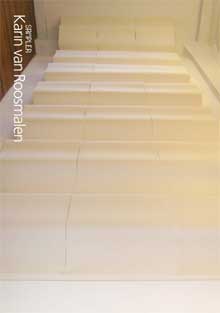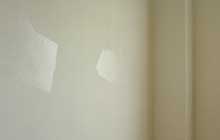 |
|||||||||
|
|
| ...GALLERY EXHIBITS 2004 | ...Much Like a Traveller | |||||||||||||
|
Much Like a Traveller I arrived at Karin van Roosmalen’s installation Flying at a Slant at the Michael Hirschfeld Gallery, City Gallery Wellington as I might turn up at an archaeological dig - to examine a material culture and create a narrative interpreting the evidence. With one difference, this material culture is the work of a contemporary artist who I can talk to about the installation and her wider practice. It still feels like archaeology though as I, notebook in hand, work my way around the gallery peering at the section cut into the wooden floor to expose what lies underneath, poking my head behind the walls to see what lies beyond, squinting through the spy hole cut in the wall to see something I can name. The undulating paper pinned to the walls reminds me of the unbroken ground of old earthworks and the loosely grouped incidental objects, a midden, or treasure trove. It’s that first association with the past that colours the rest of my observations and is added to my previous thoughts about other work of Karin’s. I just keep finding things that trigger memories; these sit alongside my appreciation of the tangible qualities of things, forming simultaneous layers of response. I will attempt to articulate some of these responses here as I seek to forge a deeper understanding of Karin’s work and to communicate some of my associations with you, the reader. Karin’s installations form an intersection of past, present and future, creating a studied temporality as she focuses on ‘assembling with disassembling in mind’1 . Her recent past has caused her to feed the experience of an itinerant life into her work. The materials and ideas she uses refer to the past and the future, while the present exists as the location from which they are viewed. It is helpful to know that Karin’s installation practice developed as an extension of her painting, affording her a platform to explore the formal qualities of materiality and surface. In keeping with this concurrent layering of movement and time, the platform is also the surface and the present. The most obvious move beyond the surface of the present is the perforation of the architectural container. Revealing the structure that supports floors and walls disrupts linear time, predicting future action (the cut sections will be restored after the installation) and uncovering past intervention (particularly in the Michael Hirschfeld Gallery as the walls were built when the space was transformed from bar to gallery). Having reset the architectural backdrop Karin then lines it with latent objects. The potential future is symbolised by the presentation of the unmarked and undefined, the use of clean stationery and unmarked paper and in the pervasive sense of impermanence. The fresh paper and stationery hold potential in their existence as surfaces yet to be written or drawn on and as locations yet to be arrived at. Karin’s installations exist in the sort of temporary stasis experienced in transit. To penetrate, it simply requires a different type of looking; the type of looking that is done in a transit lounge, or a waiting room, when your eyes and mind are focused on different things. Karin’s work has a self-contained reserve and restraint that forms an even tension with itself, existing simultaneously as and within both painting and architecture. It is work that turns inwards (goes behind walls, under floors) as it peels back. Its stillness and poise can seem exclusive to a casual observer, playing as it does as a backdrop. As a viewer I am expected to make my own narratives or associations out of the incidental objects and modified space, all of which exude the invisible presence of the maker. It is obvious that the artist has constructed an arrangement of elements with personal resonance, I can only guess from broad hints given in accompanying writing such as this what the details might be. And so it is my memory and association that I superimpose on Karin’s backdrop. It strikes me that Karin is processing things this way, by peeling back and penetrating walls to reveal what’s behind, placing objects together, developing relationships with and between them. Karin is using objects and materials containing personal narrative to represent the intangible and transient. Touring this show to four spaces throughout New Zealand (of which this is the second), seems to do this in a more purposefully comparative manner as Karin transfers the same materials and objects from location to location. Not everything will transfer successfully, Karin’s installations respond to particular space and she will add or take away as she familiarises herself with (inhabits) the space. The work will be unpacked and unfolded to reveal its new configuration or appearance in another location (much like a traveller does). Each location functions as an impending destination, a blank exercise book ripe with potential, within which Karin will unpack her boxes and bags and sketch out her responses, creating another layer. I leave the City Gallery Wellington with several pages of scribbled notes recording my observations of the installation site, still feeling as if I have been interpreting a material culture. And now, working as a sort of prescient archaeologist I am offering an interpretation of something that doesn’t yet exist. In doing this I hope to give visitors to the Physics Room installation some insight into the complex layering of Karin’s practice. Furthermore, by writing this in between two of the installations in the series I hope to contribute to this concurrent layering of time. Charlotte Huddleston 1 Karin van Roosmalen in artist’s statement to The Physics Room, 2003. Karin van Roosmalen was born in Christchurch, where she completed a Bachelor of Fine Arts at the University of Canterbury in 1992. In 1997 she attained a Master of Fine Arts from the Royal Melbourne Institute of Technology. Karin is currently living in Wellington, where she lectures in the School of Fine Arts at Massey University. Images and text © Karin van Roosmalen and The Physics Room. View Much Like a Traveller as a PDF
|
|||||||||||||





